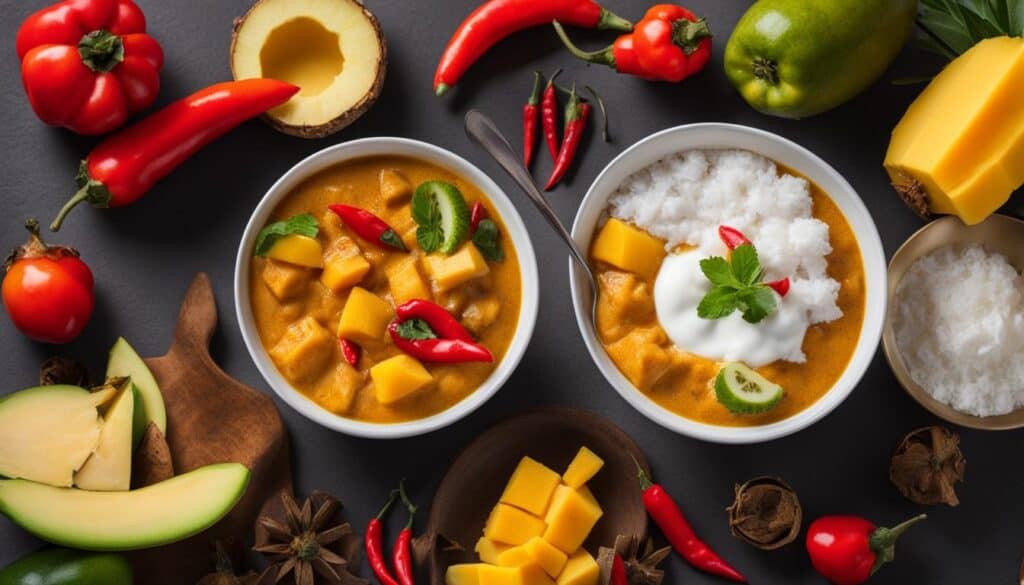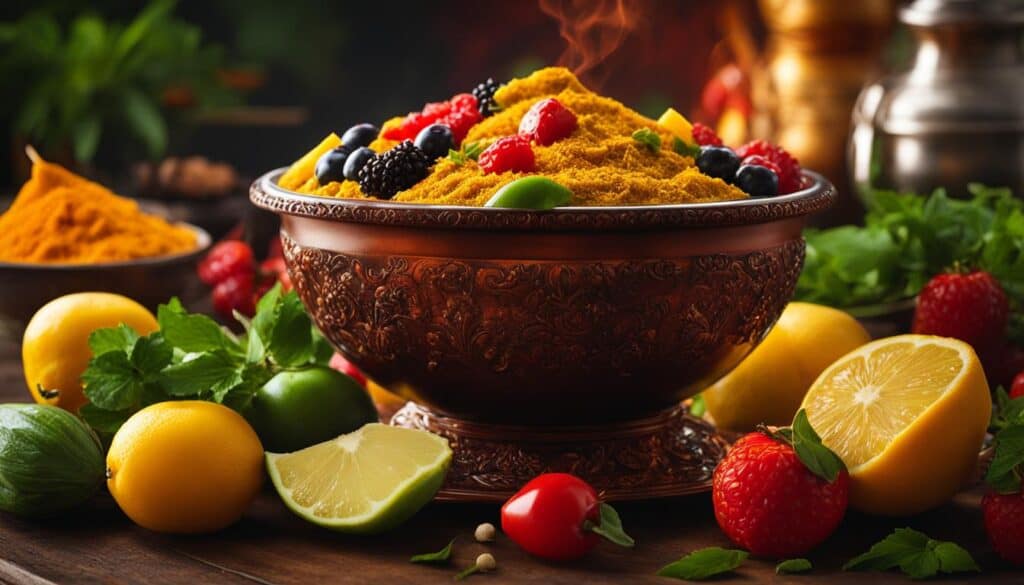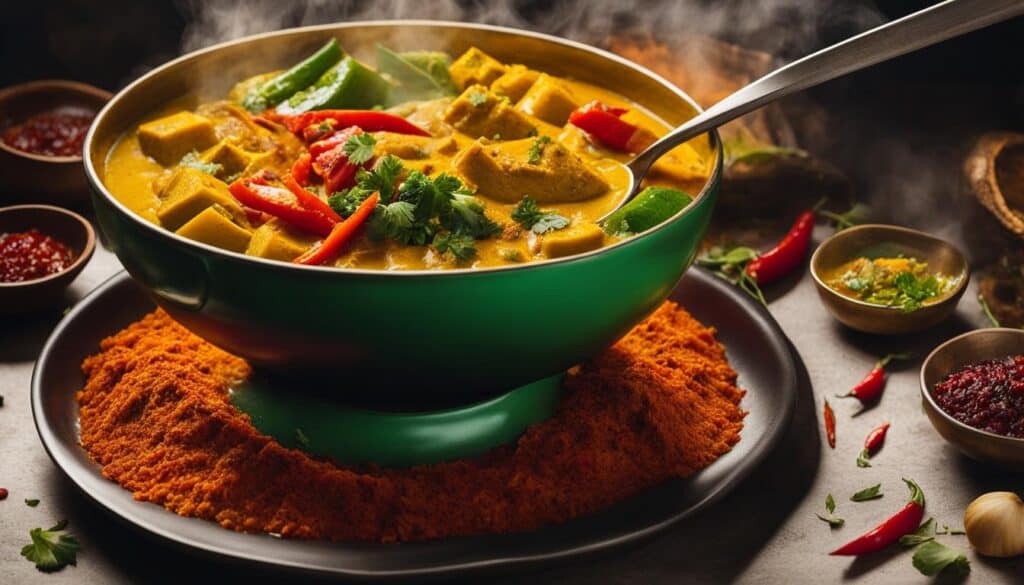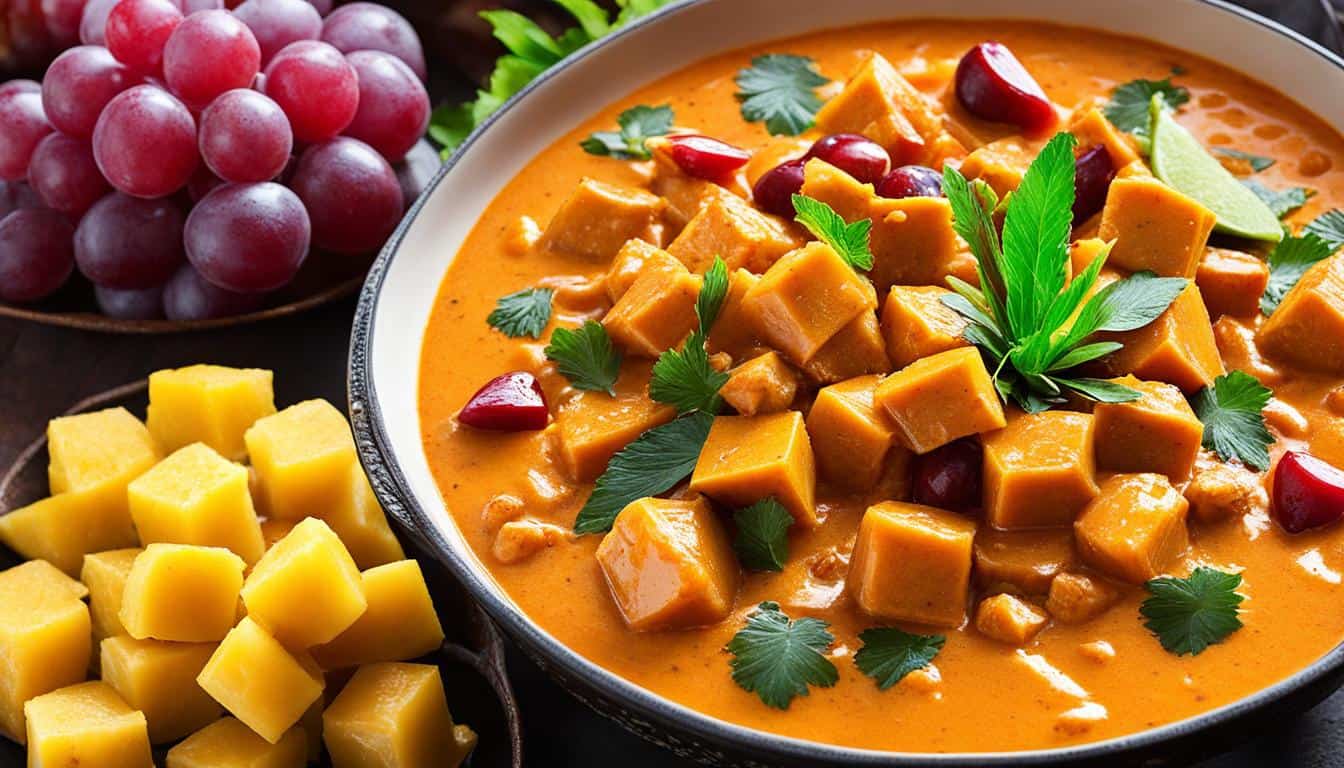Fruit in curry? You may be surprised, but adding fruit to curry dishes can create a delightful combination of flavors. Whether you’re looking for a sweet twist or a tropical touch, incorporating fruit can take your curry recipes to a whole new level. In this article, I’ll share my tips on using fruit in curry dishes, from classic southern recipes to more exotic combinations. Get ready to explore the wonderful world of fruity curry dishes!
Key Takeaways:
- Adding fruit to curry dishes can bring a unique and delicious flavor.
- Classic southern recipes like Hot Baked Curried Fruit feature a mix of canned fruits.
- For a more tropical twist, try making a Chicken, Lychees, Grapes, and Pineapple Red Curry.
- Adjusting the spice level in curry can be done by adding sweetness, incorporating dairy products, or diluting the curry.
- Experiment with different vegetables to reduce the spiciness in your curry and add more flavor.
Classic Southern Hot Baked Curried Fruit Recipe
One classic way to use fruit in curry is with the traditional southern Hot Baked Curried Fruit recipe. This recipe features a mix of canned fruits, including pineapple, pear, peach, and apricot, baked to perfection with a rich butter, brown sugar, and curry mixture. The curry adds a warm aromatic note to the fruit and enhances its natural sweetness. This dish is often served as a side dish with turkey or ham during holiday dinners and adds a touch of sweetness to the meal. Canned fruits like apricots can sometimes be difficult to find, but you can easily substitute them with other fruits to compensate.
Ingredients:
- Canned pineapple chunks
- Canned pear halves
- Canned peach slices
- Canned apricot halves (or substitute with other fruits)
- 1/2 cup unsalted butter
- 1/2 cup brown sugar
- 1 tablespoon curry powder
Instructions:
- Preheat the oven to 350°F (175°C).
- Drain the canned fruits and arrange them in a baking dish.
- In a small saucepan, melt the butter over medium heat.
- Add the brown sugar and curry powder to the melted butter.
- Stir until the sugar is dissolved and the mixture is well combined.
- Pour the butter mixture over the fruits in the baking dish.
- Place the baking dish in the preheated oven and bake for 30-40 minutes, or until the fruits are tender and the sauce is bubbly.
- Remove from the oven and let it cool for a few minutes before serving.
“This Hot Baked Curried Fruit recipe is a classic southern dish that adds a delightful sweetness to any meal. The combination of the caramelized fruits and the aromatic curry sauce is simply irresistible.” – Chef James
Enjoy this delicious vegetarian fruit curry as a side dish or serve it over rice as a main course. The rich flavors and tropical touch of the fruits make it a crowd-pleasing dish for any occasion.
Chicken, Lychees, Grapes, and Pineapple Red Curry
For a more adventurous and tropical twist, try making a Chicken, Lychees, Grapes, and Pineapple Red Curry. This curry combines the sweetness of lychees, grapes, and pineapple with the savory flavors of chicken and red curry paste. The combination of fruity sweetness, tanginess, and spiciness creates a perfect harmony of flavors. This curry was inspired by a dish from a Thai restaurant and can be easily recreated at home. It’s a fantastic option if you’re looking to add a fruity and exotic touch to your curry repertoire.
If you’re ready to embark on a culinary adventure, this Chicken, Lychees, Grapes, and Pineapple Red Curry is the perfect recipe to try. The tropical flavors of the lychees, grapes, and pineapple infuse the dish with a delightful sweetness that complements the savory chicken and aromatic red curry paste. The bright colors and vibrant flavors of this curry make it a feast for the senses.
To make this tantalizing dish, start by sautéing chicken pieces in a pan until cooked through. Next, add diced pineapple, halved lychees, and whole grapes to the pan. Allow the fruits to soften slightly and release their juices. Then, stir in a generous scoop of red curry paste and coconut milk for a luscious, creamy base. Let the curry simmer on low heat to allow the flavors to meld together.
Once the curry has thickened and the fruits have absorbed the aromatic spices, it’s time to serve. The fruity sweetness of the lychees, grapes, and pineapple adds a burst of flavor to every bite of succulent chicken. The richness of the coconut milk and the heat of the red curry paste balance out the sweetness, creating a perfectly balanced dish.
This Chicken, Lychees, Grapes, and Pineapple Red Curry pairs wonderfully with steamed jasmine rice or fragrant basmati rice. The mild sweetness of the rice complements the bold flavors of the curry, creating a truly memorable meal. Add a sprinkle of fresh cilantro or Thai basil on top for a pop of freshness and color.
With its exotic blend of tropical fruits and aromatic spices, this curry is sure to impress your family and friends. It’s a great option for special occasions or when you simply want to elevate your weeknight dinner. So why wait? Gather the ingredients, put on your apron, and embark on a flavorful culinary journey with this Chicken, Lychees, Grapes, and Pineapple Red Curry.
Adjusting the Spice Level in Curry
Sometimes, a curry can turn out spicier than expected, leaving you searching for ways to tone down the heat. Luckily, there are simple methods to make a curry less spicy without compromising on flavor.
One of the easiest ways is to adjust the amount of spice you use in the recipe. By reducing the quantity of hot peppers, chili powder, or other spices, you can bring the heat level down to your desired preference. This allows you to maintain the integrity of the flavors while ensuring your curry is enjoyable for all.
To further neutralize the spiciness, you can add acidic ingredients like lemon juice or vinegar. These ingredients help to balance out the heat, providing a refreshing contrast to the spice. The acidity of the lemon juice or vinegar helps to mellow down the spiciness, resulting in a more pleasant and well-rounded curry.
If you’d like to incorporate a touch of sweetness into your curry, ingredients like sugar or honey can do the trick. Adding a small amount of sugar or honey helps to counterbalance the spiciness, creating a harmonious blend of flavors. Just be careful not to add too much sweetness, as it can overpower the other ingredients in your curry.
And if all else fails, serving your curry with cooling accompaniments like yogurt or raita can help alleviate the spice. The coolness of the yogurt or raita provides relief to your taste buds and helps balance out the heat. It’s the perfect way to enjoy a flavorful curry while keeping the spice level in check.
Remember, when it comes to adjusting the spice level in curry, it’s all about finding the right balance of flavors. Whether you prefer a mild or fiery curry, these methods will help you create a curry that suits your taste buds perfectly. Experiment with different techniques and ingredients until you achieve a curry that is spiced just the way you like it.
| Method | Description |
|---|---|
| Adjust Spice Quantity | Reduce the amount of hot peppers, chili powder, or other spices to control the heat level. |
| Add Acidic Ingredients | Include lemon juice or vinegar to neutralize the spiciness and provide a refreshing contrast. |
| Incorporate Sweetness | Add a small amount of sugar or honey to balance out the spiciness with a touch of sweetness. |
| Serve with Cooling Accompaniments | Pair your curry with cooling yogurt or raita to help alleviate the spice and provide relief to your taste buds. |

With these techniques, you can easily make your curry less spicy and still enjoy a flavorful and delicious meal. Don’t be afraid to experiment with different methods and ingredients to find the perfect balance of spice in your curry.
Tips for Using Dairy Products to Reduce Spice
When your curry turns out spicier than desired, there’s no need to worry. Dairy products, such as yogurt, cream, or coconut milk, can come to the rescue. Not only do these ingredients have a cooling effect, but they also help mellow down the spice without compromising the flavor of your dish. So, let’s dive into some tips on how to use dairy products to tame the heat in your curry.
1. Yogurt: A Creamy and Tangy Solution
One of the simplest and most effective ways to reduce spiciness in your curry is by adding a dollop of plain yogurt. Its creamy texture and tangy flavor provide a delightful contrast to the heat, creating a more balanced taste. Simply stir in a spoonful of yogurt into your curry and enjoy the cooling sensation it brings.
2. Cream: Smooth and Indulgent
If you prefer a richer and creamier curry, consider adding a splash of cream. The velvety texture of cream helps to tone down the spiciness while adding a touch of luxury to your dish. Whether you opt for heavy cream or a lighter alternative like half-and-half, it’s sure to lend a satisfying richness to your curry.
3. Coconut Milk: Tropical Creaminess
For tropical fruit curries or dishes with a Southeast Asian twist, coconut milk is the way to go. Its lush and creamy consistency pairs perfectly with fruits and spices, creating a harmonious blend of flavors. Simply replace some or all of the liquid in your recipe with coconut milk to enjoy a creamy, mildly spiced curry with a delightful hint of coconut.
“The addition of dairy products like yogurt or cream not only reduces spiciness but also adds a creamy texture and enhances the overall taste of the curry.”
4. Experiment and Find Your Perfect Balance
Experimenting with the amount of dairy you add to your curry can help you find the perfect balance of flavors. Start with a small amount and taste as you go, gradually adding more until you achieve the desired level of spiciness. Remember, everyone’s heat tolerance differs, so it’s important to adjust the amount of dairy according to your own preference.
By incorporating yogurt, cream, or coconut milk into your curry, you can reduce spiciness while adding a creamy and indulgent touch to your dish. The cooling effect of dairy products helps achieve a more harmonious flavor profile, making your curry a delight for the senses.
Balancing Spice with Sweetness
Adding sweetness to your curry can counterbalance the spice and create a harmonious blend of flavors. You can incorporate sweetness by adding ingredients like sugar, honey, or even fruits like mango or pineapple. The natural sugars in these ingredients help neutralize the spiciness and add a delightful touch of sweetness to your curry. Adjust the amount of sweetness according to your preference, but be careful not to overpower the other flavors in the dish. It’s all about achieving a perfect balance between sweetness and spice.
When it comes to making curry less spicy, using sugar or honey can be a game-changer. Not only do they provide sweetness, but they also help counteract the heat of the spices. Sugar and honey have the ability to tame the spiciness without compromising the overall flavor profile of the dish.
If you find your curry to be excessively spicy, try adding a teaspoon of sugar or honey at a time, stirring well, and tasting as you go. This will help you find the perfect balance of sweetness and spice. Remember, the goal is to enhance the flavors and create a well-rounded curry that appeals to your taste buds.
While sugar and honey are excellent choices for adding sweetness to your curry, don’t limit yourself to just these options. Fruits like mango, pineapple, and even raisins can also contribute to the desired level of sweetness. The natural sugars in these fruits complement the spices in curry dishes, offering a pleasant contrast and a burst of fruity flavor.
To give you an idea of how to incorporate sweetness into a curry, here’s a simple recipe:
Sweet and Tangy Mango Curry
- 1 ripe mango, peeled and diced
- 1 onion, finely chopped
- 2 cloves of garlic, minced
- 1 tablespoon curry powder
- 1 cup coconut milk
- 1 teaspoon sugar
- Salt to taste
- Fresh cilantro for garnish
In a pan, sauté the onion and garlic until golden brown. Add the curry powder and cook for a minute to release its flavors. Stir in the diced mango and coconut milk. Simmer for 10-15 minutes until the mango is soft and the flavors meld together. Add sugar and salt to taste. Serve the mango curry over steamed rice or with naan bread. Garnish with fresh cilantro and enjoy the tantalizing combination of sweetness and spice.

Adding sweetness to your curry is a fantastic way to balance the spice and create a delightful culinary experience. Whether you choose to use sugar, honey, or fruits, the key is finding the right amount to achieve the desired taste. With a touch of sweetness, your curry will become a well-rounded dish that satisfies your cravings for bold flavors.
Diluting the Curry to Reduce Spice
If you find your curry to be too spicy, there’s a simple solution to tone down the heat: dilute it with water or broth. By gradually adding small amounts of liquid, you can reduce the spiciness and achieve the desired spice level. This method not only adjusts the flavor but also allows you to control the consistency of your curry.
When diluting the curry, keep in mind that adding more liquid may increase the overall quantity of the dish. To maintain the optimal balance of flavors, it’s important to adjust the other ingredients accordingly. Don’t worry, though, as the goal is to find the sweet spot where the spiciness is subdued while the flavors remain bold.
Experiment with different amounts of water or broth until you achieve the perfect balance between spiciness and flavor. Diluting your curry not only reduces the heat but also opens up new possibilities for customization. You can adjust the consistency and experiment with the other components of your curry to create a unique and delicious dish that suits your taste buds.
Using Milder Spices and Herbs
If you prefer a milder taste in your curry, you can opt for milder spices and herbs to replace the spicier ones. Some alternatives include cumin, coriander, turmeric, paprika, or even cinnamon. These spices still infuse rich flavors into your curry but with less spice. Experiment with different combinations to find the perfect blend that suits your taste buds. Remember, the goal is to create a flavorful curry with a milder heat level.
| Spice | Description |
|---|---|
| Cumin | A versatile spice with earthy and nutty flavors that add depth to curries. |
| Coriander | A mild spice with a slightly citrusy and floral aroma that complements various curry dishes. |
| Turmeric | A bright yellow spice known for its earthy flavor and health benefits. It adds a vibrant color to curries. |
| Paprika | A mild spice made from dried red peppers, adding a subtle smoky flavor and vibrant color to curries. |
| Cinnamon | A warm and sweet spice that adds a unique depth of flavor to both sweet and savory curries. |
By using milder spices and herbs, you can enjoy a curry that is packed with delicious flavors while keeping the heat level in check. Don’t be afraid to experiment and find your perfect balance of spices to create a curry that satisfies your taste preferences.

Adding Vegetables to Reduce Spice
Looking for a way to reduce the spiciness in your curry? Adding vegetables to your dish can be a game-changer. Not only do vegetables bring more texture and flavor to your curry, but they also help absorb some of the heat, making it milder and more enjoyable.
The addition of vegetables serves as a fantastic buffer, diluting the spiciness and creating a well-balanced curry. Some great options to consider include potatoes, carrots, and bell peppers. These vegetables not only complement the flavors of your curry but also add nutritional value to your meal.
Embrace your culinary creativity and experiment with different vegetables. Discover your preferred combination of veggies that can help reduce the spiciness while enhancing the overall taste of your curry. Let your taste buds guide you on a journey to a less spicy yet incredibly delicious curry!

Benefits of Adding Vegetables to Curry
- Vegetables bring additional texture and flavor to your curry.
- They help absorb some of the heat, reducing spiciness.
- Vegetables act as a buffer, creating a milder and more enjoyable curry.
- They add nutritional value, making your meal healthier.
Experiment with Different Vegetables
Here are some vegetables you can consider adding to your curry:
| Vegetable | Flavor Profile | Suggested Curry Pairing |
|---|---|---|
| Potatoes | Starchy, mild | Indian potato curry |
| Carrots | Slightly sweet, earthy | Thai red curry |
| Bell Peppers | Sweet, crunchy | Mexican vegetable curry |
“Adding vegetables to curry not only reduces spiciness but also enhances the overall flavor profile. Don’t be afraid to get creative and explore new combinations!”
By incorporating vegetables into your curry, you can strike the perfect balance between spice and flavor. So, go ahead and add some veggies to your next curry creation for a satisfying and less spicy culinary experience.
Conclusion
In conclusion, incorporating fruit into curry dishes can lead to delicious and unique flavors. Whether you’re exploring classic southern recipes or taking a tropical twist, there are endless possibilities to experiment with. Remember to adjust the spice level to your preference and utilize techniques such as adding sweetness, incorporating dairy products, and balancing flavors.
By finding the perfect combination of ingredients and spices, you can enjoy curries that are flavorful and mildly spiced. Don’t be afraid to get creative and try out some fruity curry recipes for a healthy and delightful meal. With a touch of fruit, your curries will become even more tantalizing to your taste buds. So, dive into the world of healthy fruit curry and elevate your culinary experiences today!
FAQ
Can fruit be used in curry?
Yes, fruit can be used in curry to add a unique and delicious flavor to the dish.
How can I incorporate fruit into my curry recipes?
There are many ways to incorporate fruit into curry, such as adding it to traditional southern recipes or creating tropical fruit curries.
What are some fruit curry recipes?
Some examples of fruit curry recipes include the classic southern Hot Baked Curried Fruit recipe and the Chicken, Lychees, Grapes, and Pineapple Red Curry.
How can I make a spicy curry less hot?
To make a spicy curry less hot, you can adjust the amount of spice, add acidic ingredients like lemon juice or vinegar, incorporate sweetness, or serve it with cooling accompaniments like yogurt or raita.
Can I use dairy products to reduce the spiciness in my curry?
Yes, dairy products like yogurt, cream, or coconut milk can help reduce the spiciness in curry and provide a milder taste.
How can I balance the spice in my curry with sweetness?
You can balance the spice in your curry by adding sweetness with ingredients like sugar, honey, or fruits like mango or pineapple.
Is there a way to dilute the spiciness in curry?
Yes, you can dilute the spiciness in curry by adding water or broth to reduce the heat.
Are there milder spices and herbs I can use in my curry?
Yes, spices like cumin, coriander, turmeric, paprika, or cinnamon can be used to replace spicier ones and achieve a milder taste in your curry.
Can adding vegetables reduce the spiciness in curry?
Yes, adding vegetables like potatoes, carrots, and bell peppers to your curry can help absorb some of the heat and make it milder.
Are fruit curry dishes healthy?
Fruit curry dishes can be healthy, especially when balanced with nutritious ingredients and prepared with moderation.





Leave a Reply